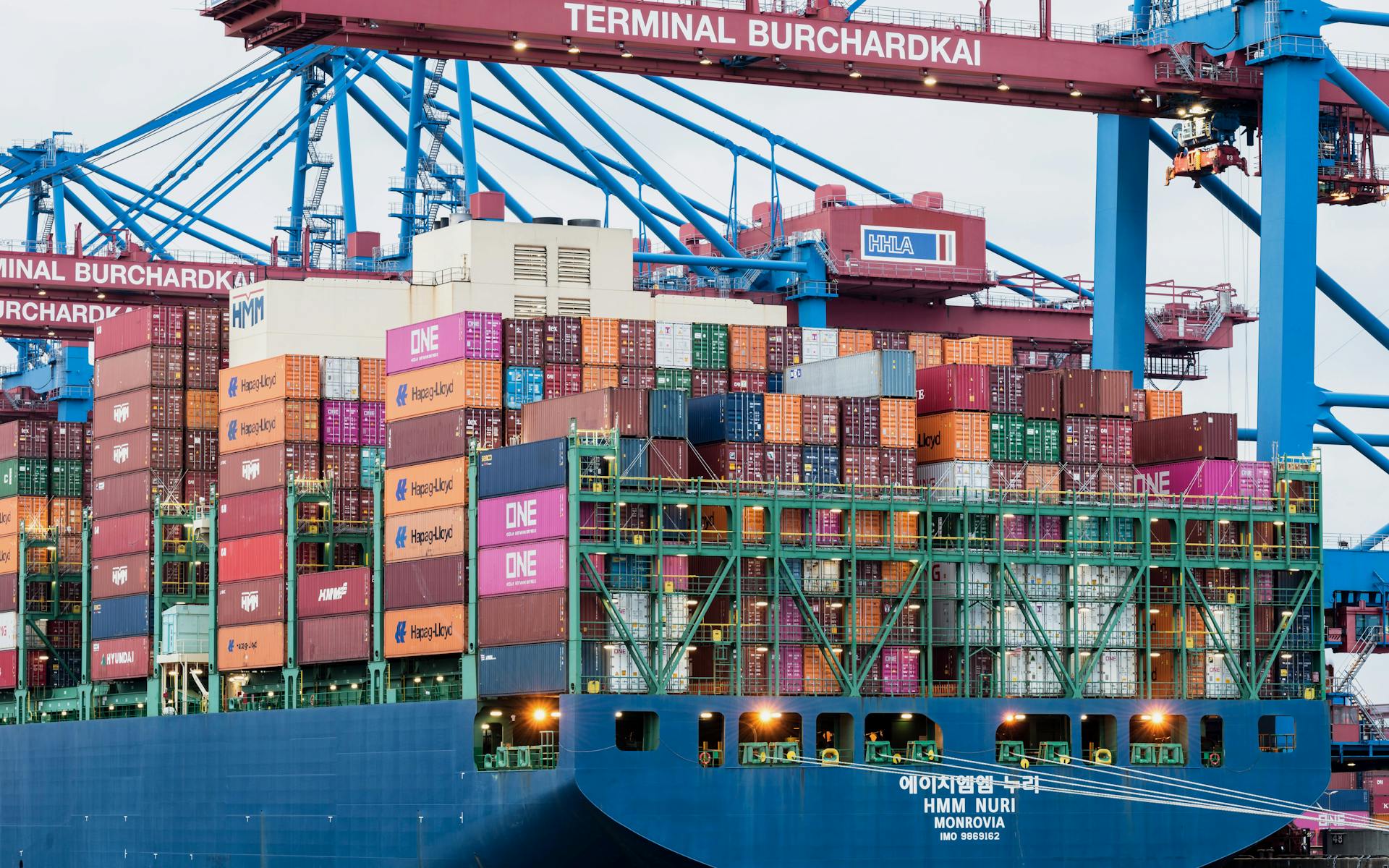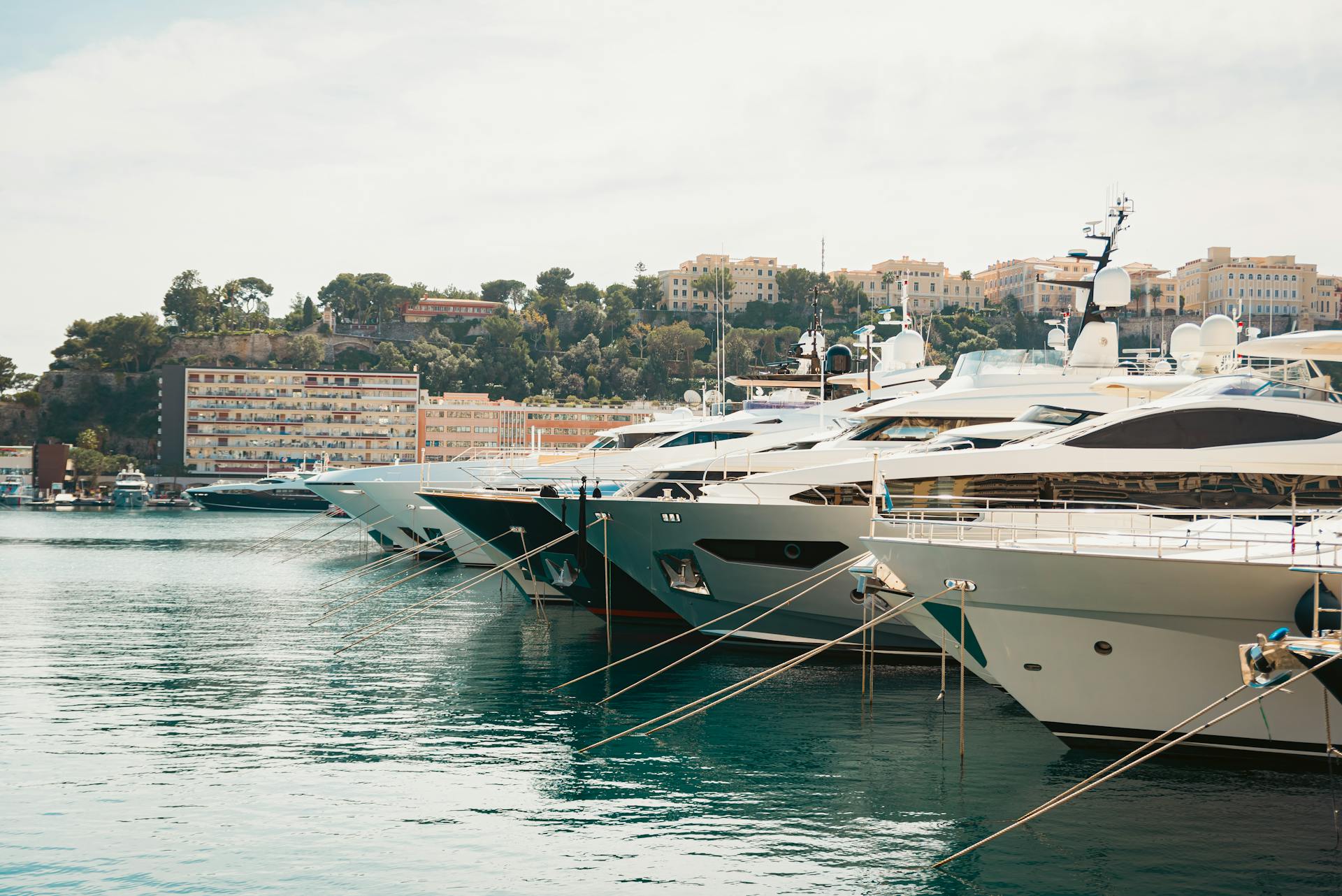
The size of the tug boat you need depends on the water you'll be operating in. For inland waterways, a tug boat up to 40 feet in length is suitable.
Consider the power of the tug boat's engine. A 200-400 horsepower engine is sufficient for smaller waterways, while 500-1000 horsepower is better for larger areas.
When it comes to maneuverability, a tug boat with a shallow draft is ideal for navigating narrow waterways. These boats typically have a draft of less than 6 feet.
The type of operations you'll be performing also affects the size and capabilities of the tug boat. For example, a tug boat with a bollard pull of 10-20 tons is suitable for assisting larger vessels in tight spaces.
Expand your knowledge: Transportation Boat
Types of Small Tug Boats
There are several types of small tug boats, each designed for specific tasks and operations. Harbor tugboats are small vessels that assist in the movement of ships within and around ports.
They're highly maneuverable and have powerful engines that help with safe berthing, unberthing, and cargo handling of large vessels. Harbor tugboats are equipped with fenders to protect them and the ships they handle.
Ocean-going tugboats operate in the open sea and are used for various operations, including towing barges and drilling rigs. They're larger than harbor tugboats and have a more powerful engine to handle the challenges of ocean towing.
Specialized tugboats are built for specific tasks, such as operating in freezing conditions or assisting in salvage operations. They're equipped with cranes and other specialized gear to get the job done.
Small harbor tugboats are smaller versions of traditional harbor tugboats, used in smaller ports or for operations that don't require large tugboats. They're still powerful and highly maneuverable, making them ideal for assisting small to medium-sized vessels.
Here are the main types of small tug boats:
- Harbor Tugboats
- Ocean-going Tugboats
- Specialized Tugboats
- Small Harbor Tugboats
Functions, Features & Design
Small tug boats are incredibly versatile vessels that play a crucial role in maritime transport. They can assist ships in berthing, unberthing, and maneuvering through difficult waterways, making them essential for various operations.
Small tug boats are designed with powerful engines that provide the necessary force for towing and maneuvering, making them reliable and efficient for various towing operations. These engines generate high horsepower for pushing and pulling vessels.
Their robust hulls are constructed of steel or reinforced materials to withstand heavy seas and sustain long-term use. This is crucial for operations in harsh weather conditions.
Small tug boats are highly maneuverable, enabling them to operate in tight spaces and perform complex towing operations with precision. This is due to their wide beams and low centers of gravity, providing stability and preventing capsizing during towing operations.
Some of the key features of small tug boats include non-slip decks, sturdy railings, and safety equipment to protect the crew and cargo. These safety features are essential for ensuring the well-being of those on board.
Here's a breakdown of the typical sizes for small tug boats depending on their intended use:
These sizes are just a guideline, and the actual size of a small tug boat will depend on the specific requirements of the operation and the size of the vessels being towed or assisted.
Choosing a Small Tug Boat
Choosing a small tug boat requires careful consideration of several key factors. The primary purpose of the tugboat is crucial in determining the type of vessel to choose. For example, if the main focus is on harbor operations, a tugboat with high maneuverability and shallow draft, like a Z-pull tug, would be ideal.
Power and performance are also essential factors to consider. Assess the power requirements based on the intended operational scale, considering factors like the size of the vessels to be towed or assisted, the distances involved, and the environmental conditions. More powerful tugboats are needed for larger vessels and more challenging sea conditions.
To ensure fuel efficiency, analyze fuel consumption rates in relation to expected workload and operational patterns. Tugboats with better fuel efficiency may have higher upfront costs but can lead to significant savings over time, especially for businesses with high operational volumes.
Choosing for Sale
Choosing the right small tug boat for sale involves considering several key factors. These factors will impact the vessel's operational efficiency, maintenance, and suitability for specific tasks.
First and foremost, you need to define the primary purpose of the small tugboat. Will it be used for harbor operations, offshore towing, inland waterway transport, or another specific function? Knowing the primary use will help narrow down options to those best suited for the specific operational requirements.
The power requirements of the tugboat are also essential to consider. Assess the power requirements based on the intended operational scale, taking into account the size of the vessels to be towed or assisted, the distances involved, and the environmental conditions.
Fuel efficiency is a critical factor for both operational cost-effectiveness and environmental sustainability. Analyze fuel consumption rates in relation to expected workload and operational patterns. Tugboats with better fuel efficiency may have higher upfront costs but can lead to significant savings over time.
The maneuverability and draft of the tugboat are also important considerations. Shallow draft tugboats are more maneuverable and can operate in shallow waters, making them suitable for ports and inland waterways. Deep draft tugboats offer greater stability and power in open waters but require deeper water.
Here are some key factors to consider when choosing a small tug boat:
- Purpose and scope of operations
- Power and performance
- Fuel efficiency
- Maneuverability and draft
- Regulatory compliance and environmental considerations
Some common types of small tug boats for sale include harbor tugboats, ocean-going tugboats, specialized tugboats, and small harbor tugboats. Each type has its unique characteristics and is suited for specific tasks.
Harbor tugboats are small vessels that assist in the movement of ships within and around ports. They are highly maneuverable and have powerful engines that help with the safe berthing, unberthing, and cargo handling of large vessels.
Ocean-going tugboats, on the other hand, operate in the open sea and are used for various operations, including towing barges, drilling rigs, and even disabled ships. They are larger than harbor tugboats and have a more powerful engine to handle the challenges of ocean towing.
Specialized tugboats are built for specific tasks, such as ice-class tugboats, salvage tugboats, and small harbor tugboats.
9' Boat for All Ages
The TUBBY TUG is a 9' boat that's perfect for kids of all ages. They'll love being the captain or explorer, chugging out into an imaginary world.
For safety, the TUBBY TUG has four watertight compartments that provide flotation even if the boat is filled with water. This means you can have peace of mind while on the water.
Related reading: Travel from Miami to Key West by Boat
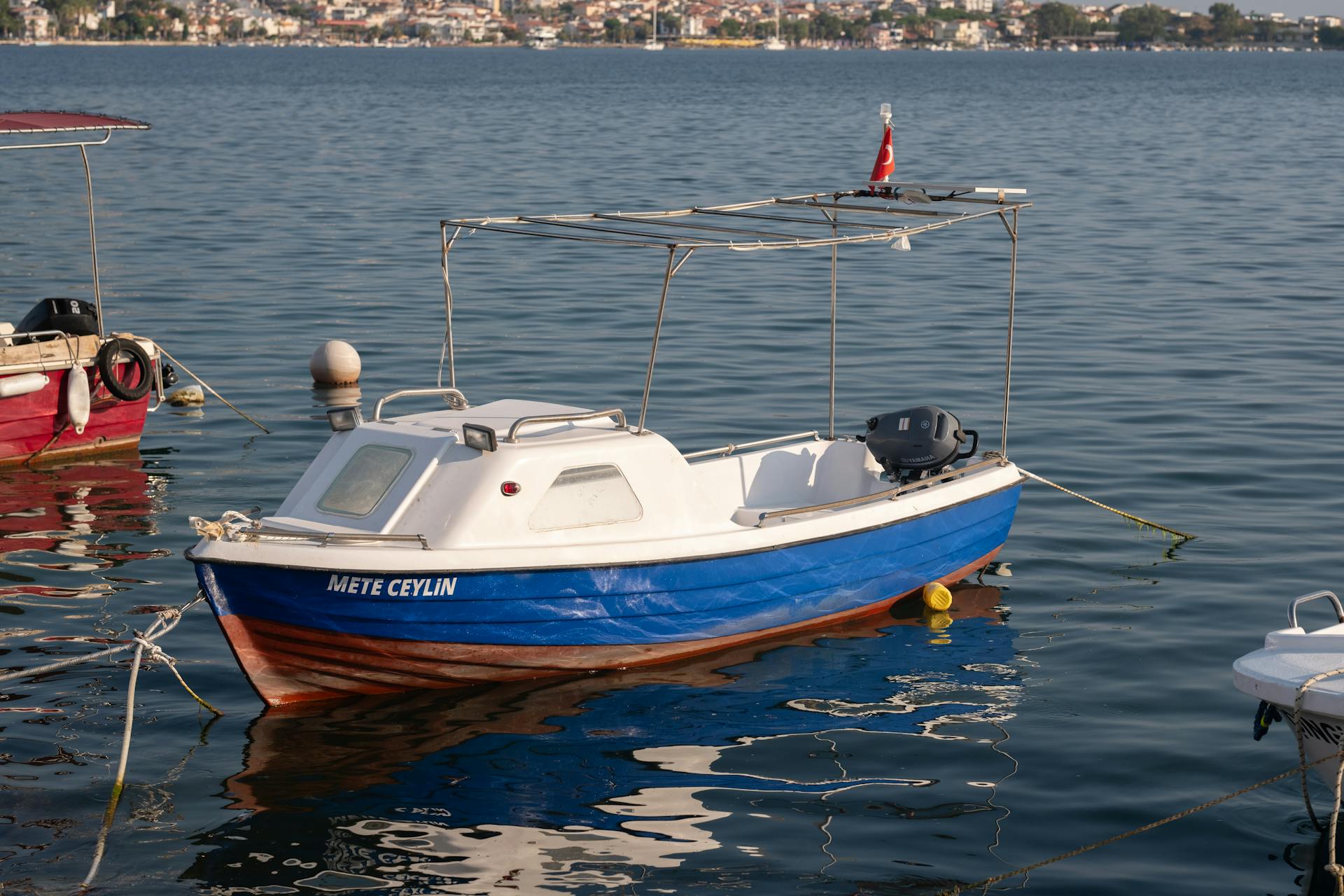
The wide beam and generous hull depth of the TUBBY TUG provides more stability than most small boats, making it a great choice for families.
You can build the TUBBY TUG using standard 8' sheets of plywood and the Stitch and Glue construction method, which is described in detail in the catalog. This makes building the boat a fun project.
The plans for the TUBBY TUG include full-size patterns for every part of the hull, including planking and decking. This ensures that the boat takes shape quickly and easily.
On a similar theme: Alaska Boat Insurance
Scenarios and Uses
Small tug boats are incredibly versatile and play a vital role in various operations in the marine industry. They're essential for harbor operations, helping move larger vessels around the harbor and assisting with mooring and unmooring ships.
In confined harbor spaces, small tugboats are especially valuable due to their maneuverability. They can navigate shallow and narrow waterways that larger vessels cannot access, making them ideal for canal and river transport.
Small tugboats are used in a range of scenarios, including offshore operations, the fishing industry, emergency services, and recreational use. They assist in positioning and anchoring offshore platforms, move supplies and equipment, and provide support during construction and maintenance operations.
Here are some of the key scenarios where small tug boats are used:
- Harbor Operations: assisting with mooring and unmooring ships, and moving larger vessels around the harbor.
- Canal and River Transport: navigating shallow and narrow waterways, and pushing barges and other vessels.
- Offshore Operations: positioning and anchoring offshore platforms, moving supplies and equipment, and providing support during construction and maintenance operations.
- Fishing Industry: helping place and retrieve fishing gear, and transporting fish from fishing vessels to processing plants.
- Emergency Services: assisting with search and rescue operations, oil spill response, and marine salvage operations.
- Recreational Use: participating in tugboat races and festivals, and being used for recreational activities such as fishing and pleasure cruising.
Scenarios
Small tug boats are incredibly versatile and essential tools in the marine industry. They're used in a variety of operations, but their key usage scenarios include harbor operations, canal and river transport, offshore operations, the fishing industry, emergency services, and recreational use.
In harbor operations, small tug boats help move larger vessels around the harbor, including container ships, bulk carriers, and oil tankers. They also assist with mooring and unmooring ships, ensuring safe and efficient docking and departure.
Small tug boats are especially valuable in confined harbor spaces where maneuverability is crucial. They can navigate tight spaces and help larger vessels get in and out of the harbor.
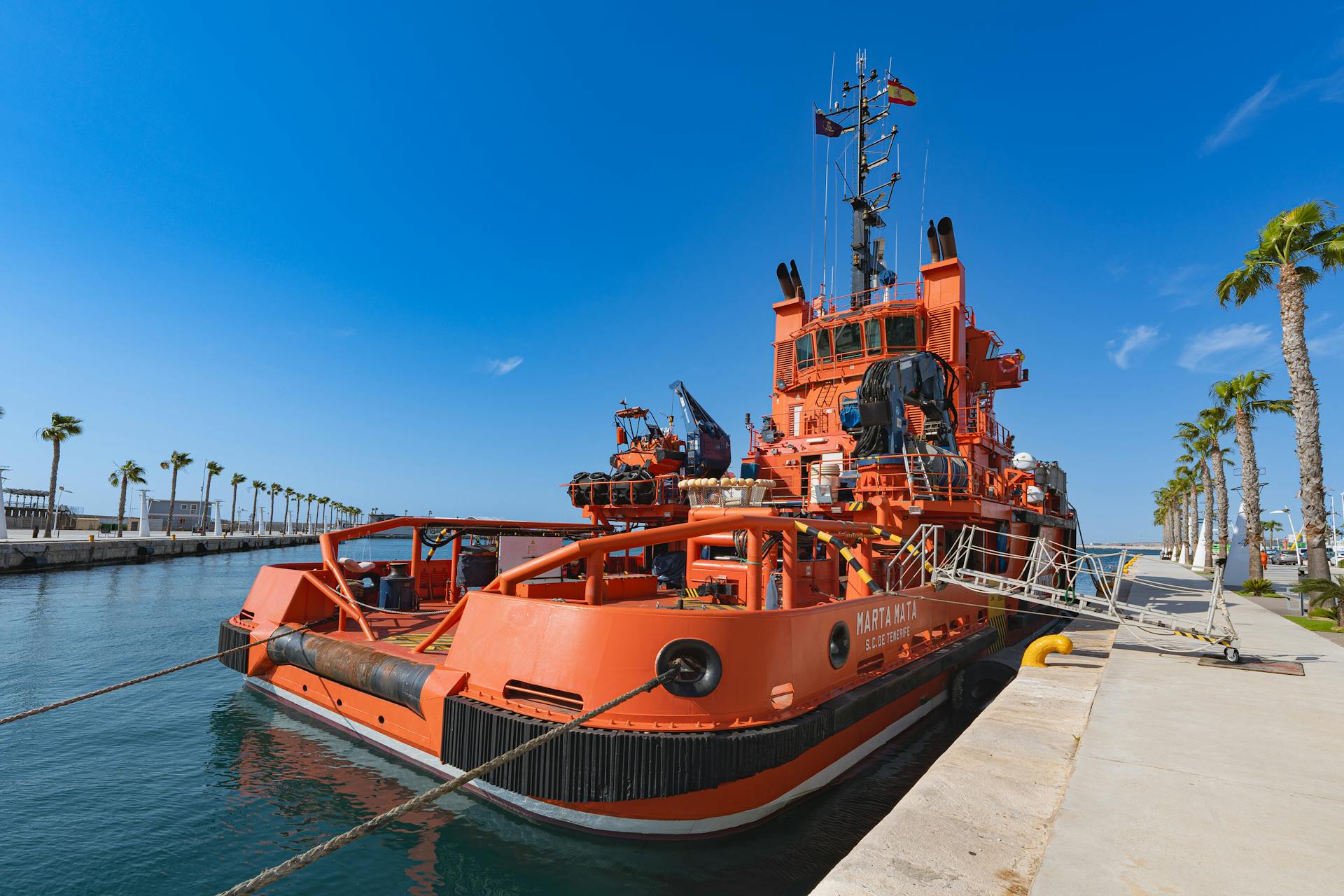
In canal and river transport, small tug boats are essential for transporting goods and materials via canals and rivers. They can navigate shallow and narrow waterways that larger vessels cannot access.
Here are some key uses of small tug boats in different scenarios:
- Harbor Operations: moving larger vessels, assisting with mooring and unmooring ships
- Canal and River Transport: transporting goods and materials via canals and rivers
- Offshore Operations: assisting in positioning and anchoring offshore platforms, moving supplies and equipment
- Fishing Industry: placing and retrieving fishing gear, transporting fish from fishing vessels to processing plants
- Emergency Services: search and rescue operations, oil spill response, marine salvage operations
- Recreational Use: pushing or towing smaller vessels, participating in tugboat races and festivals
Scenario for Sale
If you're in the market for a small tug boat, you'll want to consider its potential uses. Small tug boats can assist larger ships to berth and unberth, helping them navigate through congested waters.
In ports, small tug boats are used for loading and offloading at docks, as well as maintenance and repair work. They're also essential for moving vessels around the port.
Here are some of the key scenarios where small tug boats can be used:
- Port Operations
- Harbor Services
- Offshore Operations
- Coastal and Inland Waterways
- Salvage and Recovery
- Emergency Services
- Recreation and Tourism
- Research and Education
- Farming
These scenarios showcase the versatility of small tug boats, which can be used for both commercial and recreational purposes.
Q&A
Small tugboats can navigate tight spaces with ease, thanks to their turning radius, which ranges from 50 to 100 meters.
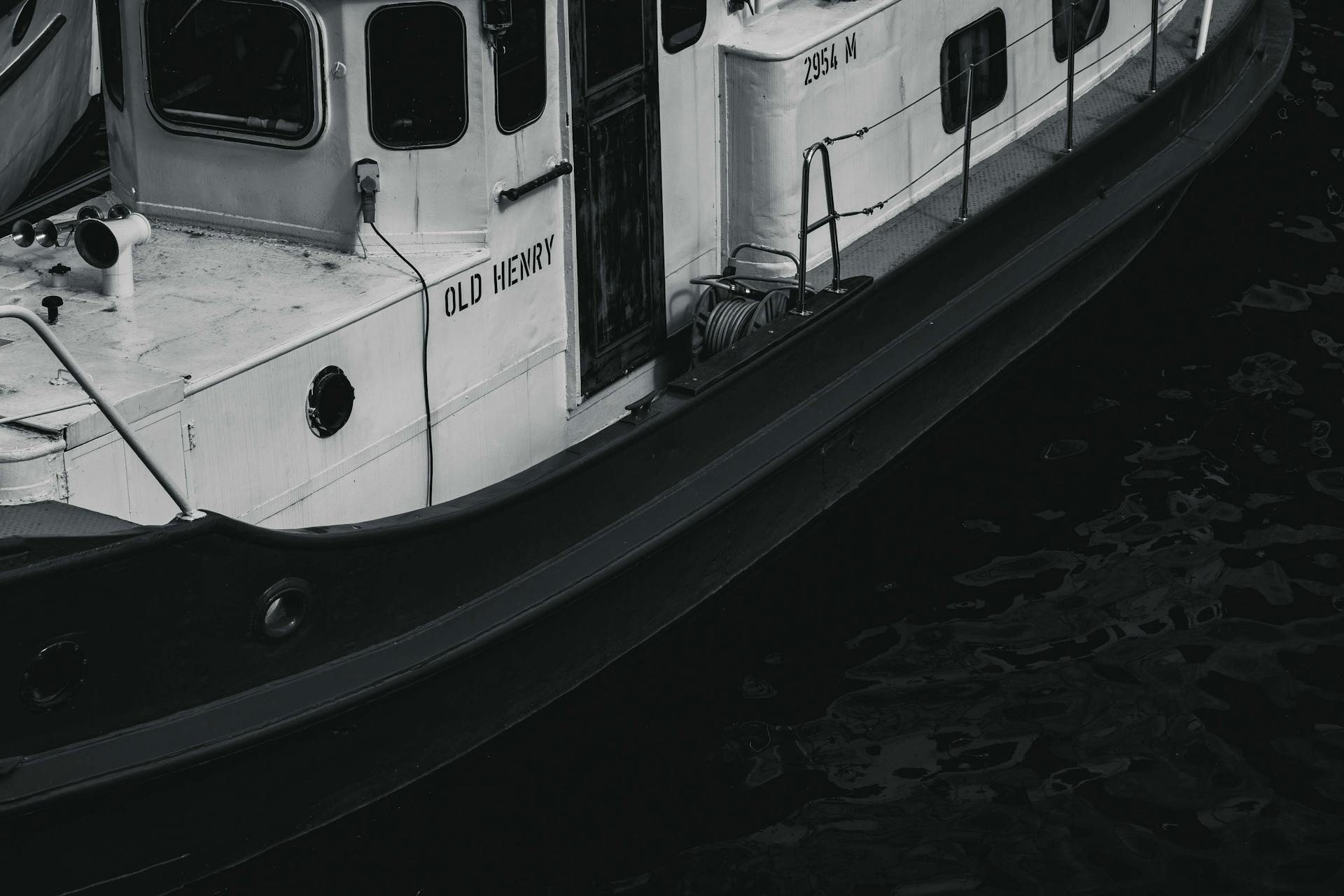
Their ability to operate in confined areas is crucial for carrying out harbor operations.
A typical day for a small tugboat is 8 to 12 hours long, depending on the workload and operational requirements.
Continuous operation for many hours requires regular maintenance to ensure safety and optimal performance.
Proper care and maintenance can extend the lifespan of a small tugboat to about 30 to 40 years.
Regular surveys and inspections are necessary to ensure the tugboat is in good condition and to address any issues that may arise.
Frequently Asked Questions
What is the smallest tugboat?
The smallest tugboat in the Navy is the "Boomin Beaver", a tiny but mighty vessel that plays a crucial role in keeping larger ships safe.
What is the lifespan of a tug boat?
Tugboats typically last 30-35 years, but with mid-life rehabilitation, they can be extended to 45-50 years of service.
Featured Images: pexels.com

